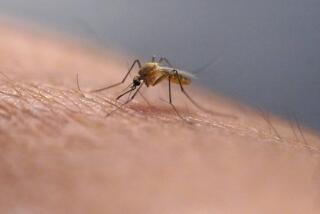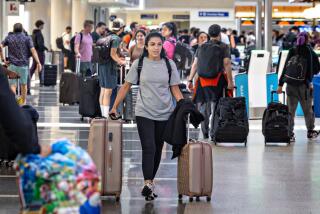Pay attention to ills that may be lurking at your destination
DENGUE fever has plunged Singapore into a health crisis, and public health officials worldwide are worried that avian flu will trigger a human influenza pandemic.
Those developments reaffirm a basic travel truism: No one is truly prepared for a trip until he or she knows what diseases or conditions lurk at the destination — whether it’s New England or Indonesia — and how to minimize the risk.
FOR THE RECORD:
CDC flu guidelines —The Oct. 9 Healthy Traveler column reported that travelers should avoid eating poultry in areas where avian flu is found. The federal Centers for Disease Control and Prevention says influenza viruses are destroyed by heat and advises people to cook poultry and poultry products, such as eggs, thoroughly before eating. In the same column, “all babies” were included in CDC recommendations for people who should get flu shots. The CDC advises the shots for babies 6 to 23 months old, babies 6 months and older with chronic heart or lung conditions and children older than 23 months with health problems.
Here, some risks you should know about now and what to do to boost the odds of staying healthy while traveling.
Dengue fever: In Singapore, the Ministry of Health reported an average of 204 dengue fever cases a week in the first half of 2005.
The most current statistics available show that more than 8,850 cases, with eight deaths, have been reported.
Dengue, spread by the bite of infected Aedes mosquitoes, is most common in tropical and subtropical areas. Those 15 to 24 years old are most susceptible.
After a three- to 14-day incubation, an infected person is likely to have a high fever, severe headache and joint and muscle pain. A rash typically surfaces about five days after the fever and can spread from the torso to the extremities and the face, according to the federal Centers for Disease Control and Prevention in Atlanta.
The severity of the disease varies greatly, and there is no treatment. Sometimes it goes away on its own, and sometimes it is severe enough to be fatal. A rare form, called hemorrhagic, is severe.
“There is no medication for dengue,” says Dr. Gerald Brennock, a Mission Viejo internist who specializes in travel medicine. Nor is there a vaccine.
“The only protection is good insect repellent,” Brennock says. He recommends using 20% DEET repellents.
Wearing long-sleeved clothing also can help.
Bird flu: Avian influenza, or H5N1, is prevalent in Indonesia and other destinations. From January 2004 until Sept. 22, 115 human cases of bird flu had been reported (91 in Vietnam, 17 in Thailand, four in Cambodia and three in Indonesia), according to the CDC; 59 have died.
Most of the cases are thought to have been caused by direct contact between humans and infected poultry. Travelers are advised to avoid eating or having any other contact with any poultry or poultry products, as well as surfaces contaminated by the birds.
Although a vaccine is under study, it’s not yet available.
In people, bird flu symptoms resemble those typical of influenza, including fever, sore throat and cough. They can include eye infections, pneumonia or respiratory diseases.
Research suggests that some medications approved for human flu virus might work in preventing bird flu. Brennock says that for the last two years he has been giving Tamiflu (oseltamavir) to his patients headed to China and other outbreak areas and advises them to take it if bird flu breaks out at their destination.
Tamiflu may not be readily available overseas, the State Department says. Americans interested in having it for their trip should consult a doctor in the U.S. before departure.
Influenza: Get a flu shot before you travel, Brennock advises adult travelers. It might prevent you from being detained if, for instance, you travel to areas where severe acute respiratory syndrome, or SARS, might strike.
“If you develop influenza in China — because it is indistinguishable from SARS, they would detain you,” Brennock says.
He recommends a flu shot for adult travelers, especially if their destination is China, Thailand or Vietnam.
He also recommends it if you are traveling to South America, “where they have [the] flu all year long,” he says.
(The CDC recommends flu shots for those 65 and older, those who live in nursing homes, children 6 months and older with chronic heart or lung conditions, all babies, and others with health problems.)
Influenza symptoms include fever, headache, fatigue, dry cough, sore throat and muscle aches.
In the United States, flu season peaks from late December through March; up to 20% of the population is expected to get it each year.
Symptoms usually occur two days after exposure to the virus, which is spread when an infected person sneezes or coughs and sends virus-filled droplets into the air.
Experts advise that you consider yourself contagious for at least five days after developing symptoms.
Allergies
: Fall foliage tours can be less than beautiful if you’re prone to fall allergies.The good news? “If you are headed to Vermont, the ragweed is gone by October,” says Dr. Jonathan Corren, a West Los Angeles allergist and immunologist and associate clinical professor of medicine at the UCLA David Geffen School of Medicine. But elm trees may be pollinating, and outdoor mold can be at high levels, at least until the first frost, he says.
What should you take: “I tell patients to take non-sedating antihistamines so they don’t fall asleep in the middle of dinner.” Two good over-the counter choices include Claritin and Alavert (loratadine).
“They are reasonably effective non-sedating antihistamines,” he says.
If you’re under an allergist’s care, take the medications your doctor prescribes.
To find out if pollen and mold levels will be high at your destination, check the National Allergy Bureau information at https://www.aaaai.org/nab . Click on “Pollen & Mold Count” on the left-side menu, and you can search by destination.
Healthy Traveler appears every other week. Kathleen Doheny can be reached at [email protected].
More to Read
Sign up for The Wild
We’ll help you find the best places to hike, bike and run, as well as the perfect silent spots for meditation and yoga.
You may occasionally receive promotional content from the Los Angeles Times.






